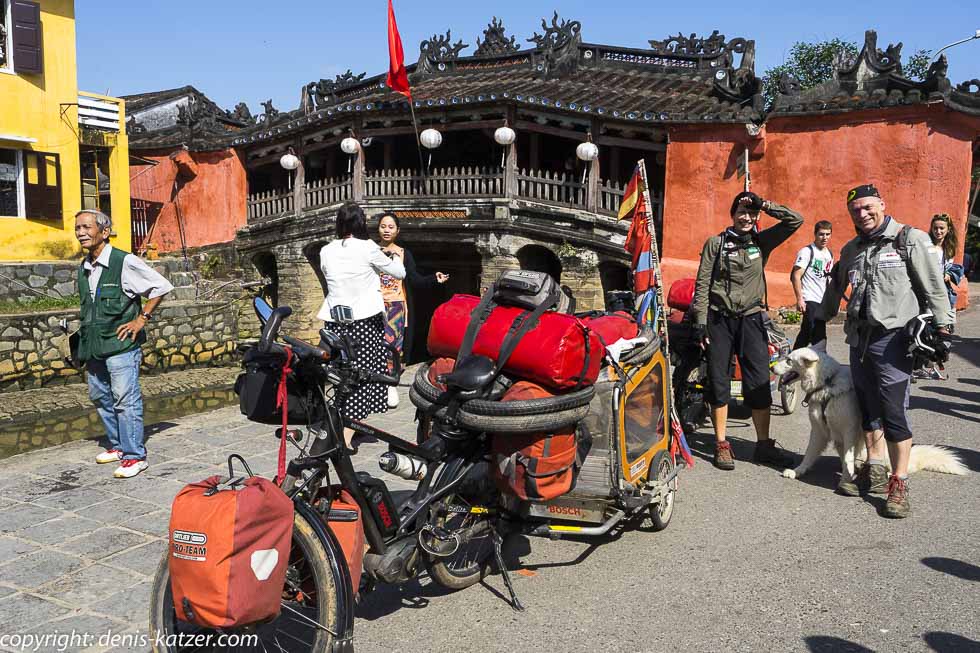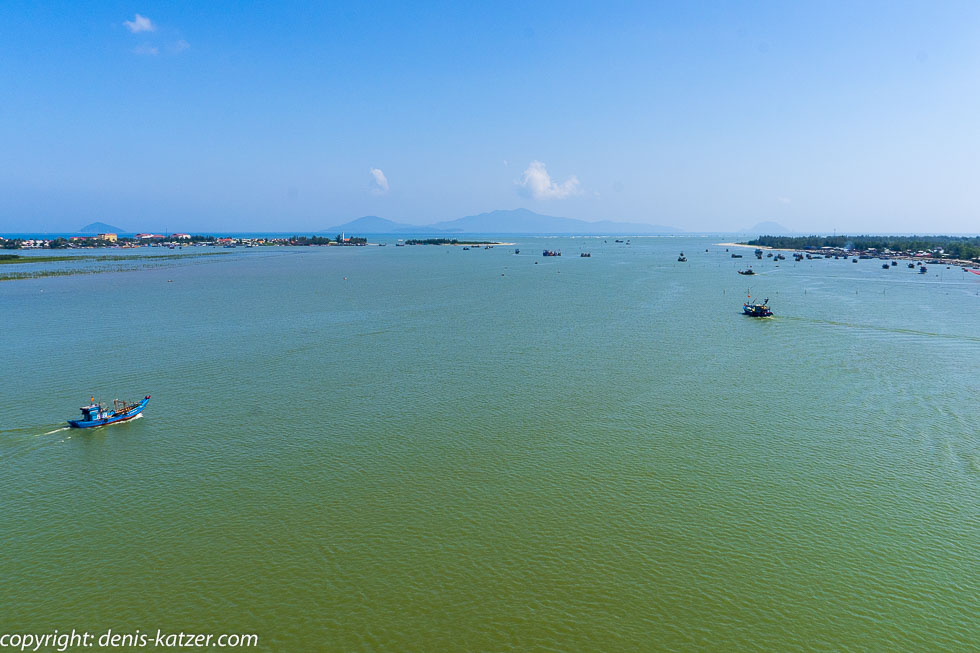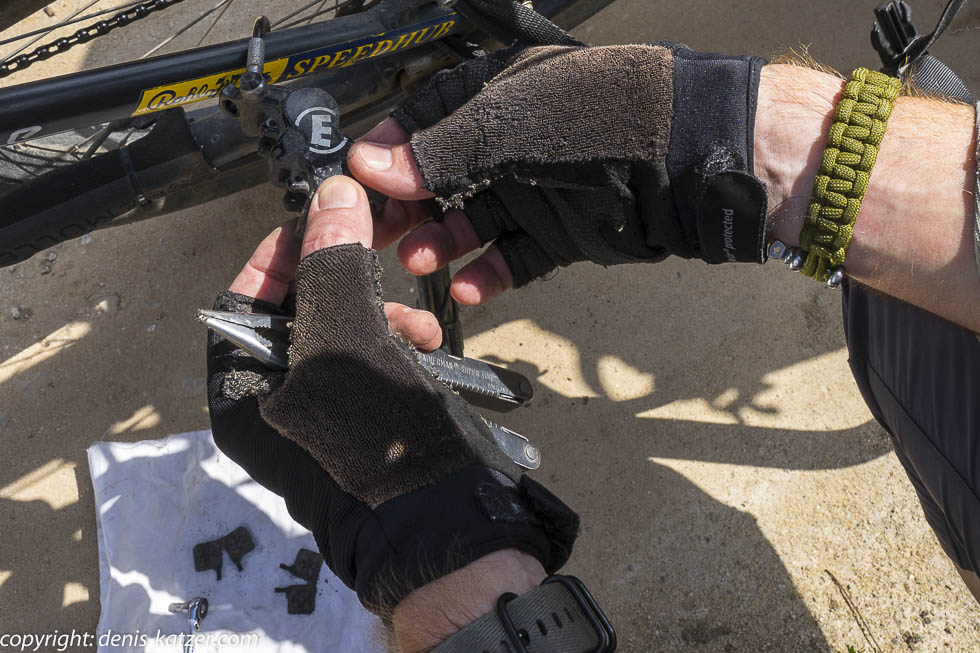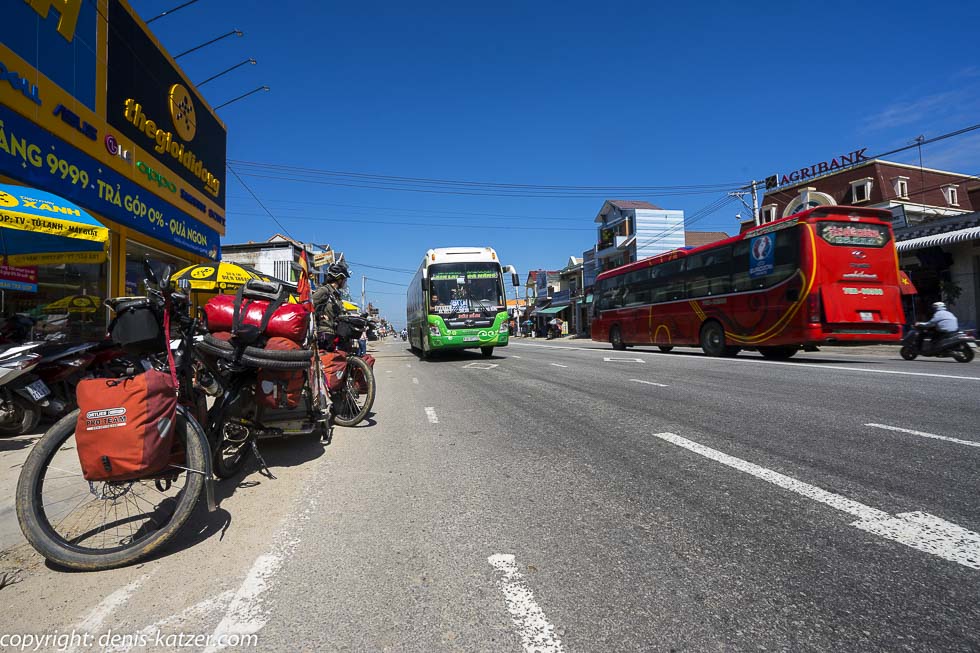
Inaccurate navigation – stranded on Highway 1A
N 15°22'22.4'' E 108°43'22.8''
Date:
06.02.2017
Day: 587
Country:
Vietnam
Province:
Quảng Nam
Location:
Street Hostel
Latitude N:
15°22’22.4”
Longitude E:
108°43’22.8”
Daily kilometers:
88 km
Total kilometers:
21,746 km
As the crow flies:
70 km
Average speed:
23 km/h
Maximum speed:
47 km/h
Travel time:
Soil condition:
Asphalt
Maximum height:
16 m
Total altitude meters:
59.258 m
Sunrise:
06:17 – 06:15
Sunset:
17:42 – 17:45
Temperature day max:
26°C
Departure:
09:30 a.m.
Arrival time:
4:30 pm
(Photos of the diary entry can be found at the end of the text).
“Let’s take a few more photos at the Japanese Bridge,” Tanja suggests. “Why not,” I reply and set the MAPS.ME app to cycling. This leads us to our destination via small side roads. The historic alleyways of Hoi An’s old town are already filled with tourists from all over the world in the morning. With our road trains and Ajaci in his caravan, we stand out like colorful dogs. The Japanese Bridge is already teeming with people at 9:30 am. We steer our bikes through the crowds and park them in front of the bridge. We are immediately surrounded and asked where we come from. “From Germany,” we reply. “And you had your bikes flown to Saigon or Hanoi by plane?” “No, we cycled from Germany to here.” “Oh, that’s not possible?” “Yes, it is,” I reply. It only takes minutes and the Japanese Bridge is no longer the main motif for tourists, but our heavily laden bikes and Ajaci. “You know, we’re cyclists too. Not as extreme as you, but we cycle every summer.” “Oh Karl, what are you talking about. We only go on short weekend trips,” his wife replies with a grin. “Weekend trips can also be adventurous. You don’t have to cycle around the world to experience something,” Tanja reassures us. “Exactly,” says the husband to his wife with a wink. “We should leave, otherwise we’ll be crushed,” warns Tanja. “Or thrown into the filthy cesspit down there,” I reply, pointing to the canal next to us, where a few dead fish are stretching their bloated bellies towards us. “Have a nice trip,” we wish some of the tourists standing next to us, get into the saddle and leave the hustle and bustle. “Do you know where to go?” asks Tanja. “Sure, I’ll just follow the directions from MAPS.ME. The cycle route takes us to Highway 1A via side roads,” I reply in a good mood. Just one kilometer later, the road ends on the banks of the Thu Bon River. Since when can wheels swim? “And now?” “Well, I wish I knew. The app has navigated us to a ferry station. It can’t know that there’s no ferry waiting to take us to the opposite shore. Maybe they’ve stopped the ferry service completely? What a bummer,” I curse and study the map again. Then we drive back, always along the river, until we come to a kind of dead end again. “It simply makes no sense to use the bike setting on MAPS.ME. It’s simply too imprecise. I thought the programmers had improved it over the last 1 ½ years, but maybe it’s too much to ask to find a working bike connection in Southeast Asia. From now on we will also navigate in cities with the car setting again. We’re on the safe side,” I decide.
After 9 kilometers back and forth we are back in front of the accommodation from where we started 30 minutes ago, even though we have a considerable distance of about 116 km ahead of us today and Tanja is plagued by a cold. Finally we reach a mighty, modern bridge over the Thu Bon. We put the bikes on the stand and enjoy the view of the wide delta of the river, which flows into the China Sea just a few kilometers away from here. The Thu Bon once led the trading ships of the Silk Road via this route to the city of Hoi An, whose harbor was the largest in Southeast Asia at the time. However, nature played a devastating trick on Hoi An by silting up the harbor. One reason why the town became less and less important in the 18th century.
According to my map study, we should cross the southbound Highway 1A in 20 kilometers at the latest and then take side roads from the east, i.e. the coast of Vietnam, to the west to Ho Chi Minh Road. This means that we are forced to cross the central highlands again and also have to take a considerable detour, but we are spared the crazy traffic on Highway 1A. Sure, we could just follow this main road south and save ourselves a few days on this much shorter route, but on our tour it’s not about getting from A to B within a set time, but about exploring the country, its inhabitants and nature for ourselves and, above all, having fun while cycling. Apart from that, the shorter route is not always really shorter. Sometimes it can even cost a cyclist their life or at least put them at risk.
“The road should meet the 1A here,” I wonder, studying the map again at the marked point. “Maybe this dusty track leads there?” Tanja ponders, pointing to a sandy track that is obviously under construction, which branches off from our asphalt road and winds its way westwards. “Yes, that could be the connection to 1A.” “Should we follow it?” “Hm, with our heavy luggage? I don’t know. It’s really hard on the material because of the bad potholes. Above all, this dirt track might just end in the middle of nowhere. Then we’ll have to turn back. I think we should play it safe and follow the asphalt road further south. It will meet up with Highway 1A at some point.” “But then we’ll miss the road that takes us west across the central highlands.” “Yes, you’re right,” I reply, weighing up the potential damage and benefits. “Let’s stay on the tarmac”, I decide, because I don’t feel like having to repair broken drawbars or the consequences of other self-inflicted material fatigue.
We cycle south on the new coastal road, always looking out for a turn-off to the west. To the left and right of the low-traffic road, bright white mountains of sand stretch away. If they weren’t covered in endless graves, you would think you were crossing a lonely desert. Just under 30 km further on, the straight road ends abruptly in a village. Signs advertise that the road construction project will continue soon. We turn west and are greeted by the hectic 1A, which starts in the north on the border with China and ends at 2,301 km in the southern province of Ca Mau. We can forget the plan to simply cross it to continue west, because there is no connection to the west side for the next 100 km. As we don’t feel like cycling back more than 20 km to reach the originally planned western route, we are now forced to use the terrible Highway 1A.
Thhhuuuut! Thhhuuuut! Thhhuuuuut!, roars the tin monsters, making our hair stand on end. After just a few kilometers, our nerves are on edge. Thhhuuuut! Thhhuuuut! Thhhuuuuut!, the noise is so loud that our eardrums bulge inwards. The worst are the buses, whose horns certainly have the volume of a jet taking off. To be honest, I’m surprised that the windows of the buildings next to the highway don’t simply shatter under the infernal noise. But the frequencies of the crazy horns are far too low for that. They not only enter the body through the ear canals, but also through every pore. As soon as they have reached the inside of our body, they swing through our marrow in short waves and leave us like the rain of the past months through our shoes. A nightmare and certainly no cycling pleasure. Even the otherwise beautiful landscape around us is covered in houses, factories and other ugly buildings. On top of that, there is the enormous amount of garbage that the residents simply tip into the ditch, so that we pedal our horses along the world’s longest garbage stop. In order to get to grips with the endless flood of waste, most of which consists of plastic, it is simply incinerated in every nook and cranny. So the air is not only polluted by the exhaust fumes from the horrible piles of metal, but mainly by the burning ditches. A monstrous phenomenon that started mainly in central Vietnam and reveals the helplessness or disinterest of a ruthless, corrupt government. Because if the politicians cared about their people, they would certainly not allow their citizens to be forced to constantly poison themselves through the insane incineration of their waste. Surely only a few people know that the incineration of plastic waste produces dioxins, which, if inhaled, are absolutely carcinogenic. The poison also attacks the nervous system, the respiratory tract, the thyroid glands and the digestive tract. It also gets into the food cycle because chickens, ducks, pigs, etc. roam around looking for food in the poisoned soil. Later, we humans eat the chicken eggs or animals and absorb the toxins directly into our bodies. It’s madness, especially because the normal food chain is already heavily contaminated by dioxins and people here are not aware of the consequences because they simply don’t know. On the other hand, they have no other chance of getting rid of the waste.
Because the sun is back in the sky today after the endlessly long rainy season, it is a hot day compared to the last few months. Although we are sweating like polecats, we are happy about the rising temperatures. After about 80 kilometers we are mentally and physically exhausted from the noise stress, the exhaust fumes and the constant stench of burnt plastic and are looking for a place to stay for the night. “There’s a hotel over there,” says the owner of a street stall. At the risk of simply being run over by the endless avalanche of cars and mopeds, we cross Highway 1A with maximum concentration. We roll our bikes into the shade of a lonely tree that lives a sad life in front of the hotel. “Do you have a room for us?” I ask tiredly. “The friendly woman nods her head. She also accepts our bikes and Ajaci. I take a look at the room on the second floor. For 250,000 dong (€10.37) without breakfast, the sad and simple standard. “It’s fine,” I say to Tanja, giving her a thumbs up. We have just rolled our bikes into the long aisle and started to unload them when a Vietnamese woman in bright make-up, aged around 60, rushes towards us and shakes her head vigorously. “You can’t stay here with a dog,” she says in broken English. Because the woman at reception has already promised us a room here, we look at her a little puzzled “Okay, but if you’re staying with me, then here on the first floor. The rooms upstairs are already fully booked”, she suddenly gives in after a few minutes and shows us a tiny room without a window, but with a broken ceiling fan and faulty air conditioning. “The repairman for the air conditioning will come later,” she promises. “I’ll never believe her,” says Tanja. “Me neither,” I say. “I’m sure I’ve ended up in a brothel,” Tanja suspects. “Hm, you mean because the woman is wearing such terrible make-up?” “Among other things. But look at the two girls there. They never look like cleaning ladies.” “And neither are guests.” “Yes, and the rooms upstairs are rented out to customers in the evening. She doesn’t want us there. Mainly because she’s afraid Ajaci might squeak around and drive her guests away.” “Well, if it’s a brothel, the guests will squeal too. She doesn’t need to be afraid of a dog,” I reply with a laugh. “Thank you very much, but we’re not staying,” I say to the madam, who smiles at me with relief.
With the bikes loaded up again, we roll them onto Highway 1A, which is boiling with heat and stinking with exhaust fumes, continue our tour and two hours later reach another, completely run-down hostel. An old woman shows me musty, moldy, dark rooms for 200,000 dong. (€8.30) “Should we stay?” I ask Tanja uncertainly. “Can our bikes come in?” “Yes, we would have to carry them up the steps through the entrance hall, the kitchen and a storage room. There’s a place to park them overnight at the back.” “There’s another place like that at the front. Do you see it?” “Do you mean the house behind the big street sign?” “Yes.” “Okay, then let’s try it out,” I reply, lifting my tired right leg over the saddle and pedaling my steed there. This time the room costs 300,000 dong (€12.44) without breakfast. It’s clean, doesn’t smell of mold, but there’s a karaoke bar right next door. Although we know it’s going to be hellishly loud tonight, we check in. As soon as our bikes are stowed away and our equipment in the room, we head for the only roadside restaurant in town. Like almost all street restaurants, it is quite dirty, the tables are sticky and the floor is littered with leftover food, beer cans and napkins from previous diners. With a little effort, we make the friendly cook understand that we should not use any flavor enhancers. She gets the chilled beer from a neighbor and puts the two cans on the table. Then she sets about preparing two soups for us. As always, we fish out the meat and put it in a plastic container. “Ajaci will be happy again,” says Tanja. 30 minutes later, we leave the simple shack reasonably well-fed and walk back to our accommodation in complete darkness, always careful not to get caught by one of the 38-ton trucks thundering past. A few hundred meters ahead we can already hear the loud music and the terribly shrill and false singing that is combined with the horn concert of the 1A. The karaoke bar is in full swing. “Phew, what a day. Tomorrow we really have to see how we can get off this highway. It’s just too hectic, too dirty and too noisy on this stretch,” I say moments later, tossing and turning on the rock-hard mattress, putting the pillow over my head…
If you would like to find out more about our adventures, you can find our books under this link.
The live coverage is supported by the companies Gesat GmbH: www.gesat.com and roda computer GmbH http://roda-computer.com/ The satellite telephone Explorer 300 from Gesat and the rugged notebook Pegasus RP9 from Roda are the pillars of the transmission. Pegasus RP9 from Roda are the pillars of the transmission.








